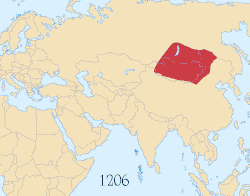User:ChryZ MUC/mongol
Mongol Empire ᠶᠡᠬᠡ ᠮᠣᠩᠭᠣᠯ ᠤᠶᠯᠤᠰ ' | |
|---|---|
| 1206–1368 | |
 Expansion of the Mongol Empire 1206–1294 superimposed on a modern political map of Eurasia | |
| Status | Nomadic empire |
| Capital | |
| Common languages | |
| Religion |
|
| Government | Elective monarchy Later also hereditary |
| Great Khan (Emperor[note 3]) | |
• 1206–1227 | Genghis Khan |
• 1229–1241 | Ögedei Khan |
• 1246–1248 | Güyük Khan |
• 1251–1259 | Möngke Khan |
• 1260–1294 | Kublai Khan (nominal) |
• 1333–1368 | Toghan Temür, Khan (nominal) |
| Legislature | Kurultai |
| History | |
• Genghis Khan proclaims the Mongol Empire | 1206 |
• Death of Genghis Khan | 1227 |
| 1250–1350 | |
| 1260–1294 | |
• Fall of Yuan dynasty | 1368 |
• Collapse of the Chagatai Khanate | 1687 |
| Area | |
| 1206 (unification of Mongolia)[1] | 4,000,000 km2 (1,500,000 sq mi) |
| 1227 (Genghis Khan's death)[1] | 13,500,000 km2 (5,200,000 sq mi) |
| 1279 (Its greatest extent) [1] | 33,000,000 km2 (13,000,000 sq mi) |
| 1294 (Kublai's death)[1] | 23,500,000 km2 (9,100,000 sq mi) |
| 1309 (last formal reunification)[1] | 24,000,000 km2 (9,300,000 sq mi) |
| Currency | Various[note 4] |
| Today part of | |
Cite error: There are <ref group=note> tags on this page, but the references will not show without a {{reflist|group=note}} template (see the help page).
- ^ a b c d e Rein Taagepera (September 1997). "Expansion and Contraction Patterns of Large Polities: Context for Russia". International Studies Quarterly. 41 (3): 475–504. doi:10.1111/0020-8833.00053. JSTOR 2600793. Archived from the original on 19 November 2018. Retrieved 8 December 2018.
